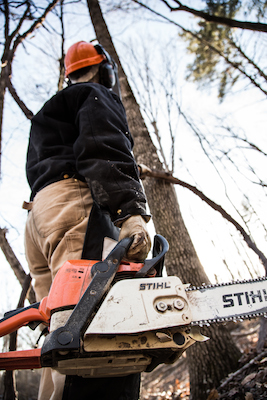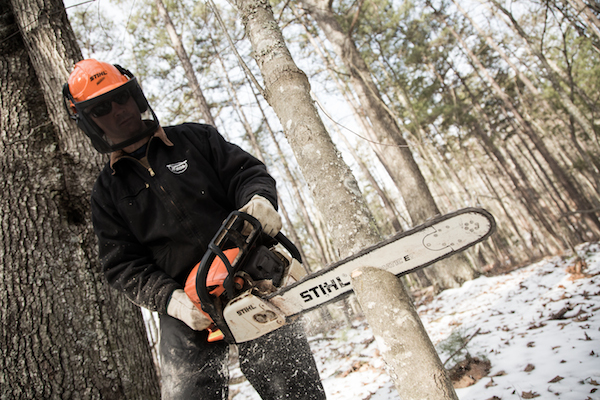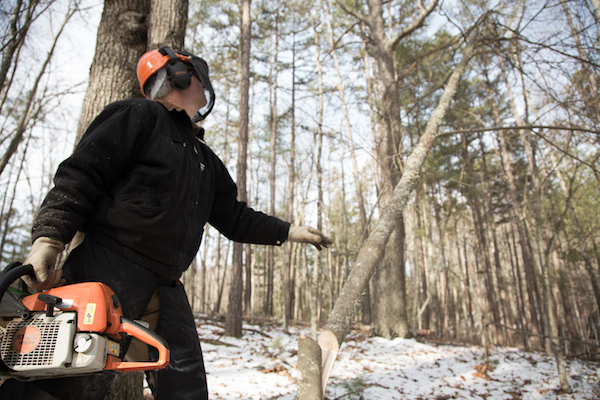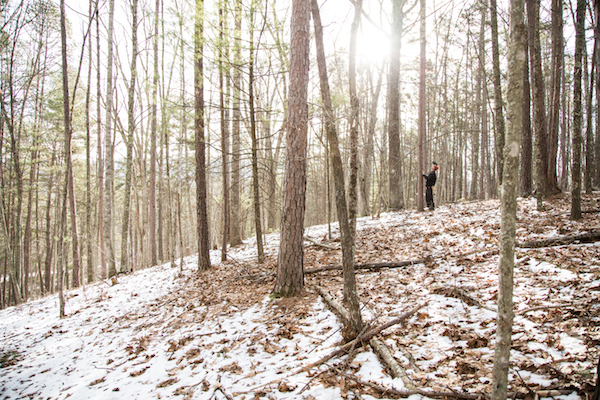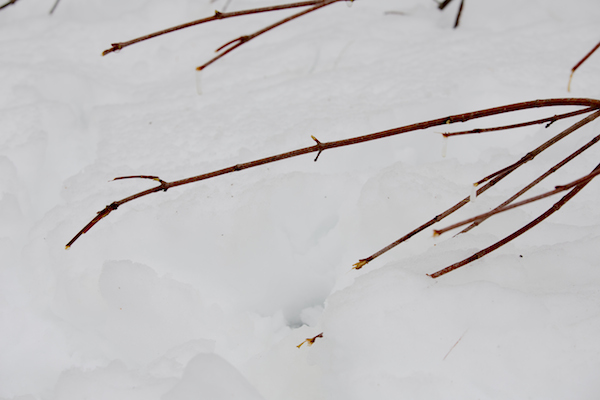LAST UPDATED: May 1st, 2015
When most deer hunters think of February, they think of brutally cold temperatures, picturesque snow painted landscapes, and deer peacefully seeking refuge from the elements. It is, after all, one of the slowest months on your average deer hunter’s calendar. The season is closed, but it’s generally too early to really put down some serious shoe leather in search of shed antlers. So, what’s a deer manager to do?
Thankfully, I have a much different idea of February in the deer woods. It involves chainsaws chewing through bark and cambium, sawdust flying, and trees crashing and falling to the snow covered forest floor. I’m talking about hinge cutting! In this post, part 1 of a 2 part series on hinge cutting, I’m going to walk you through the basics of hinge cutting, and how it can drastically make for better deer and deer hunting!
Safety First
It should go without saying that every time you fire up a chainsaw, whether it’s to hinge cut, cut firewood, or simply prune an ornamental tree in your backyard, safety should always be your first priority. Chainsaws are powerful and dangerous tools, and a little carelessness could result in serious injury or death. Simply Google image search, “Chainsaw Injury” to view the gruesome and catastrophic injuries suffered from a chainsaw.
Needless to say, if you don’t have any of the following items, then forget about running a chainsaw: Helmet, face guard, chaps, eye and ear protection, gloves, and steel toed boots. It’s not my goal to scare you or deter you from running a chainsaw however I do want to exhaust this opportunity to ensure that you do it safely.
Further, it’s important to check and determine the tree’s lean before you cut it. That is, determine which direction the tree will fall once it’s been hinged. While most hinge cut trees are small in diameter, even those trees can prove to be dangerous. If you’re inexperienced with a chainsaw, scout out a friend or family neighbor with chainsaw experience to walk your through the basics. Operating a chainsaw isn’t rocket science, but having a mentor or guide show you the ropes is very reassuring. Also, if possible, always cut with a partner, and be aware of his position and location. If this isn’t necessary, always carry your cell phone with you, and let a friend or family member know where you’ll be cutting, and when you plan on returning home.
Running a chainsaw unsafely is like hunting without a safety harness; there’s no excuse not to, and your friends and family are counting on you to come back in one piece. No deer is worth dying for.
Safety is the number 1 priority when running a chainsaw. Always wear proper safety equipment, and inspect each tree and it’s lean before cutting.
What is a Hinge Cut?
Before you fire up a saw, let’s first establish what a hinge cut actually is. A hinge cut is a habitat management technique that has been quickly growing in popularity. It’s a cheap, effective, and easy way to improve deer habitat and increase your property’s carrying capacity by increasing cover and consistent and available browse.
Simply put, a hinge cut is made by cutting roughly halfway through the tree at a slight 45-degree angle 3-4 feet off the ground, and then tipping over the tree while it’s still connected to the trunk. While this may look like certain death to the tree, the still connected heartwood allows the tree to continue to flower and fruit just as it would normally.
Simple, affordable, and practical. A hinge cut is a great management technique to incorporate into your QDM plan this winter.
Why Hinge Cut?
There are several benefits to hinge cutting as part of your deer management program. As touched on above, hinging a tree does not kill the tree. In fact, many species of hinged trees will live out their normal life expectancy after being cut. The most obvious benefit of hinge cutting is bringing down invaluable woody browse (an important part of a whitetail’s diet) and cover down to deer level.
A 75-foot tall red maple tree, standing proud and pretty, provides next to nothing for your deer herd. However, hinging that tree will provide both immediate and long-term deer browse. In addition to an instant food source, it also creates the living, horizontal cover that big bucks love, and birthing fawns rely on. Furthermore, dropping the tree opens the canopy allowing sunlight to penetrate the forest floor, which will in turn allow for new species regeneration to occur, providing additional food and cover that deer can easily access. Sounds pretty sweet, huh?
The simple truth is that hinge cuts can dramatically increase your property’s carrying capacity by providing year round food and cover. When most hunters thinking of hunting and managing timber, they think of big, powerful, towering oak trees, and for good reason. Acorns have been, and always will be, the whitetails most preferred food source when available. However, a one-acre stand of mature oaks will only produce 500-700 lbs. of deer food AT BEST in their bumper crop year, which for a white oak is roughly 3 years. Conversely, a one-acre chunk of well-managed timber either through clear cuts or hinge cuts can produce up to 2,000 pounds of deer food year round, while also providing valuable fawning cover, nesting areas for turkeys, and secluded bedding areas for mature bucks. All thanks to your chainsaw.
Hinge cutting timely provides two things deer can never have too much of this time of year: food and cover.
Where & What to Hinge Cut?
Now that we’ve established what a hinge cut is, we need to discuss what areas of your property need to be hinge cut, as well which species of trees should be cut. Before I go any further, since the whitetail’s range encompasses so many different climatic and topographic regions of the country, it would be irresponsible of to me suggest that I know which species of trees should be hinged in all areas of the country. If you’re unfamiliar with the species of trees growing in your neck of the woods, consult with a professional wildlife consultant or forester before you make a mess of things.
That being said, a general rule of thumb when hinge cutting or thinning timber for wildlife, is that if a tree doesn’t provide any valuable to wildlife standing up, bring it down. On my family’s property in Virginia, I primarily target yellow poplar and red maple trees. These trees provide nothing to wildlife once they get above deer level, and they hinge extremely well. I’ve also found that the deer on my property browse on the tender yellow poplar buds and leaves more than any other species.
In addition, both species are prolific “stump sprouters.” That is, even in the event that they’ve been hinged or cut completely they’ll continue to produce shoots of nutritious browse. I like to look for open stands of poplar and maples during the winter to hinge cut. These areas are usually painfully open and easy to spot. Hinging this pole timber provides instant bedding and deer food.
This stand of timber is badly in need of improvement. Hinge cutting the less desirable wildlife trees will thicken the understory, open the canopy, and provide immediate deer browse and cover.
There are, of course, exceptions to the rule, and there are many instances when hinging wildlife trees is a viable option. For example, picture an oak stand with oaks no more than 6 inches in diameter dominating the stand. The woods are so open you could spot a chipmunk at 50 yards. Meanwhile, 50 feet up in the air, the trees have little to no crown because they aren’t able to receive adequate sunlight. This would be a perfect situation to save the bigger, healthier looking oaks and hinge the trees around it. This accomplishes several things. For one, the tree you spared is free to expand its crown and become a stronger, healthier tree with a bigger crown, capable of producing more acorns in the future. Next, it thickens the understory making it more attractive to deer, turkeys, and all wildlife. Finally, oak buds and leaves are favorite deer browse. In addition, oaks, as well as hickories, hold their leaves much longer into the fall than other species of trees, further increasing the horizontal cover on you property.
Hinge cutting isn’t glamorous work, but the results speak for themselves. Pictured here is a red maple that’s been browsed heavily since I hinged it 2 weeks ago.
Hinge cutting is a fun, inexpensive habitat improvement technique that is limited only by your own creativity and how hard you’re willing to work. The results are both immediate and long term, improving not only the health of the wildlife on your property, but the health of the habitat in which they live as well.
In part 2 I’ll explain how to use hinge cuts to manipulate deer movement on your property to make for better bowhunting. Until then…

